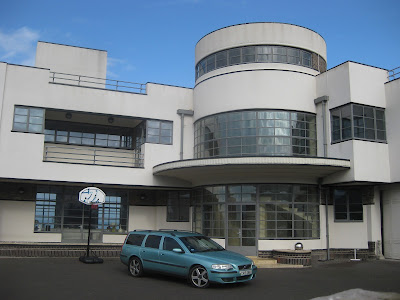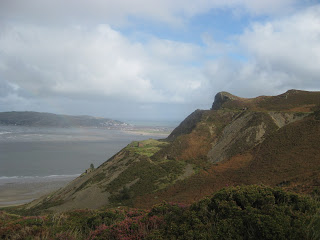I resumed the walk on this more coastal stretch where at each end it's hardly any distance from the railway station to the Path.
Starting from Conwy, I had hoped to cross the river on Telford's Suspension Bridge but I was too early - it is only open from 11 (
details here). Nevertheless, it was a chance for a good look while walking over the newer road bridge, and to admire the way the Castle has been hardly spoilt by its construction: the chains seem to pass through the castle wall. Although the bridge is the main feat of engineering, I did reflect as I walked that building the embankment across the rest of the estuary to the Deganwy side was also an achievement.
Coming off the embankment, I followed the
Conwy Estuary Trail, which at first passes round the shore side of the sea wall that the protects the Conwy Tunnel east entrance. The Trail and the North Wales Path then run together, following the shore line. This makes it easy enough to follow, although in fact I didn't see a North Wales Path sign between Conwy Castle and the side of the Great Orme.

Path, railway line and road are parallel for a while going towards Deganwy. I was struck by this 'White Cottage' on the road, just before where the B5115 turns off the A546, so much older than surrounding houses - maybe even 18th century? I haven't been able to find out any more about it.
Next we pass by Deganwy Marina. Most marinas this way have been developed at old quarry ports or fishing ports and this is no exception. Across the river is Conwy Marina which has a different story - the basin was formed to build the sections for the tunnel which were then sunk in the mudbanks and pumped out. The basin left over became the marina.
The view of the river now has passed away from the town of Conwy and looks across the estuary towards Penmaenmawr. Ysgol Aberconwy's modern buildings in pale yellow here have round towers which rather succesfully echo the town walls further back.
The Path continues along the shore, as the road and rail pass away inland, the other side of the North Wales Golf Club. Apparently, golfers are dangerous here!
Part of the proper path was closed here for repairs, but I could walk along the beach instead.
The Path then reaches Llandudno's West Shore. The town was laid out in the 1860s on flat marshland. Being developed at all once and with little topography to worry about meant they could have straight roads and this impressive Gloddaeth Avenue: the picture shows only one side but the view is straight through from the West Shore to the Promenade. The circular building on the left is the former tram terminus.
Going on, the Path at last reaches the side of the Great Orme, joins Marine Drive, and begins to ascend the side of the limestone cliffs. A private road, Llys Helig, named after a mythical kingdom lost under the sea here, has expensive looking houses with fine views, below Marine Drive, which acrries on upwards. The Great Orme is a prominent landmark from much of Snowdonia, so it's no surprise how much I could see fom here - Conwy valley to my left, Snowdonia ahead and up the east coast of Anglesey to the right. The picture takes in most of the North Wales Path I've done from the beginning.
Passing round to the North side of the Orme, the view changes. It was too hazy to see very far at sea, but I expect the Isle of Man must be visible on the clearest days from here. There's a
popular cafe open here, although I didn't visit this time, then the
lighthouse (also a Bed & Breakfast) is to be seen below the Drive.

I took a small diversion off the Path, to walk up the hairpin bends of the road to the summit of the Orme. I didn't go all the way to the top, but stopped to visit
St. Tudno's church. It is this church which gives Llandudno its name - in fact Llandudno was properly the name of this place, when the marsh between the Orme and the mainland was known as
Morfa Rhiannedd or
St. George's Bay.
It was possible to visit inside the church, some of which dates back to the 12th century. The cemetery is fairly impressive too, with an attractive Arts & Crafts style chapel (but not open to go inside).

Resuming the path, continuing eastwards, Llandudno pier and the Little Orme come into view.
Wild goats live on these steep cliffsides.
The Path now continues downwards along Marine Drive, past its tollgate, towards the Grand Hotel and the pier. The pier was very busy when I passed, and among its stalls were record shops publicising their wares - the tones of Jim Reeves and Johnny Cash were to be heard over the waves long before I got there. I walked along the short stretch of the pier which stands in fornt of the hotel. Between the Grand Hotel and the Promenade, behind some pier amusements, is the remains of the old Pavilion, burnt down in the 1990s, but some of the Victorian ironwork survives.

And here's Gloddaeth Avenue from the other end.
The walk now continued at a brisk pace along the arc of Llandudno's Premenade, passing Victorian hotels and guest houses. There follows Bodafon fields, a little gap in the built-up area, before a little suburb called Craigside. These seemed rather upmarket houses to Llandudno, many Victorian but some more recent. And in their midst, this splendid piece of Art Deco architecture.
This is Villa Marina (also known as Condover House), designed by Harry Weedon, dating from 1936 and well renovated.
Carrying on up the road, I began to think that maybe I had missed where the North Wales Path turns off - but, no, it's not until the brow of the hill, more or less opposite the Craigside Inn, where the Path turns left into the
Rhiwledyn Nature Reserve. Here it climbs a little, and there is a potential diversion here to the summit of the Little Orme. I didn't take it, and shortly the view changes again to look eastwards along the next stretch of the Path towards Colwyn Bay and beyond.
The Path descends into on old limestone quarry, passing down an incline at one point, towards still-eroding cliffs. Having come suitably equipped, I paused to collect some blackberries.
The route soon goes down some steps in to an estate of nondescript bungalows, then drops down to the beach for a while where there is no sea wall and private properties extend right down to the shoreline. After that, it steps up to a sea wall. Past Penrhyn Bay and another golf club. the sea wall gets well above the road behind it. This is believed to be the old course of the Conwy river before the Ice Ages. Then a glacier dammed up the river so high that a lake formed behind and cut through a new channel between what are now Conwy and Deganwy.

The walk now joins the
Rhos-on-Sea Heritage Trail. Here I visited St. Trillo's Chapel, a miniscule but genuinely ancient chapel on the site of celtic saint Trillo's hermitage, which stands over a well. The building is anything from 6th to 16th century.

Shortly after this, a surprise was to find a second hand bookshop,
Rhos Point Books. I quickly found two books I needed, and vowed to come back.
I walked up to Colwyn Bay pier, involved in recent controversy. Despite several signs along its side claiming it is still open, it isn't. It is in very shabby condition and the supports underneath don't look very robust. Opposite the pier, an underpass to the railway took me quickly back to the railway station to complete my trip.
Verdict: This walk is so much more urban in character than the last two stages. In summer, you could buy ice-creams several times over on this walk, and even in October I could have had a few. It's more of a walk for looking at buildings than for looking at wildlife, but then the Great Orme has a lot of rugged scenery to offer, and would make good winter outing on a very clear day.
 It starts off from Port Penrhyn in the same way, up the old Penrhyn Quarry Railway which is now part of the Lon Las Ogwen cycletrack, and here, at least when I visited, the Wales Coast Path signs had not yet arrived. At least at Llandygai the signs were in place, to follow the more sensible Llwybr Ugain Munud, rather than what I earlier referred to as the crazy way taken by the North Wales Path at that point. From here on, these paths are wholly different, the Wales Coast Path doing what it says on the tin, being mostly a shoreline walk.
It starts off from Port Penrhyn in the same way, up the old Penrhyn Quarry Railway which is now part of the Lon Las Ogwen cycletrack, and here, at least when I visited, the Wales Coast Path signs had not yet arrived. At least at Llandygai the signs were in place, to follow the more sensible Llwybr Ugain Munud, rather than what I earlier referred to as the crazy way taken by the North Wales Path at that point. From here on, these paths are wholly different, the Wales Coast Path doing what it says on the tin, being mostly a shoreline walk. 











































